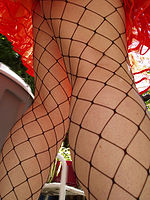- Stocking
-
This article is about the article of clothing primarily worn by women. For other uses, see Stocking (disambiguation).
A stocking, (also known as hose, especially in a historical context), is a close-fitting, variously elastic garment covering the foot and lower part of the leg. Stockings vary in color, design and transparency. By analogy, the term is also used to describe a type of horse marking in which the white coloring extends from the horse's hoof to just above the knee.
Today, stockings are primarily worn by women for fashion and aesthetics, usually in association with mid-length skirts. They can also be worn for increased warmth. They are also sometimes worn by men, and in cross-dressing and fetishism.
Contents
History
Historically, even though the word sock is at least as ancient in origin, what men normally wore were often referred to as stockings, probably especially when referring to longer hose at times when they were the fashion for men.[1] The word stock used to refer to the bottom "stump" part of the body, and by analogy the word was used to refer to the one-piece covering of the lower trunk and limbs of the 15th century—essentially tights consisting of the upper-stocks (later to be worn separately as knee breeches) and nether-stocks (later to be worn separately as stockings). (See Hose.)
Before the 1590s, stockings were made of woven cloth. The first knitting machines were for making stockings.[2] The stockings themselves were made of cotton, linen, wool or silk. A polished cotton called lisle was common, as were those made in the town of Balbriggan.
Before the 1920s, women's stockings, if worn, were worn for warmth. In the 1920s, as hemlines of women's dresses rose, women began to wear stockings to cover the exposed legs. These stockings were sheer, first made of silk or rayon (then known as "artificial silk"), and after 1940 of nylon. The first pantyhose made an appearance in the 1940s and 1950s, when film and theater productions had stockings sewn to the briefs of actresses and dancers, according to actress-dancer Ann Miller[3] and seen in popular films such as Daddy Long Legs. Today, stockings are commonly made using knitted wool, silk, cotton or nylon (see hosiery). The introduction of pantyhose in 1959 provided a convenient alternative to stockings, and the use of stockings declined dramatically. In 1970, U.S. sales of pantyhose exceeded stockings for the first time, and has remained this way ever since.[4]
Benefits and drawbacks
Stockings are sometimes preferred to pantyhose for a number of reasons. These may include the perception that stockings, and the associated use of garters, lace, high fashion, appliqué and the exposure of the thigh, are more aesthetically pleasing, or sexually attractive, than pantyhose. They are also regarded as cleaner and healthier, while pantyhose tends to create a humid and warm environment in the crotch area, increasing perspiration and potentially promoting fungal and bacterial growth. Stockings, on the other hand, provide ventilation in the crotch, resulting in a reduction of fungal and bacterial growth.
However, stockings have a drawback in colder weather, because more skin is exposed to the cold compared to pantyhose. Also, pantyhose does not require garters and garter belts, does not need to be adjusted as much, and leaves a smoother line under form-fitting clothing.
Support
Stockings can be held up in one of three ways:
- A garter belt (AmE), or suspender belt (BrE), is the most common way of holding up stockings. It is a piece of lingerie worn around the waist like a belt which has "suspenders" or "stays" that clip to the tops of the stockings to hold them in place.
- "Stay-ups" is the second most common means of support. The inside of the top of the stockings has a band (typically silicone) of elastic or highly tractive material that resists slipping down the thigh. Stay-ups have drawbacks because there is no consistent sizing for differences in thigh circumference, resulting in some stockings either falling down or being too tight, leaving red marks and possibly aggravating varicose veins.
- A garter is the least common means of support. It is slipped over the top of the stocking to hold the stocking by essentially clamping it to the leg. These are the garters typically seen at weddings. They have much the same disadvantages as "stay-ups".
Terminology
In modern usage, stocking specifically refers to the form of women's hosiery configured as two pieces, one for each leg (except for American and Australian English, where the term can also be a synonym pantyhose). The term hold-ups and thigh highs refers to stockings that stay up by the use of built-in elastic, while the word stockings is the general term or refers to the kind of stockings that need a suspender belt (garter belt, in American English), and are quite distinct from tights or pantyhose (American English).
Other terms used with stockings include:
- Cuban heel: A stocking with a heel made with folded over and sewn reinforcement.
- Demi-toe: Stockings which have a reinforced toe with half the coverage on top as on the bottom. This results in a reinforcement that covers only the tip of the toes as opposed to the whole toe. These can be with or without a reinforced heel.
- Denier: The lower the denier number the sheerer the garment. Stockings knitted with a higher denier tend to be less sheer but more durable.
- Fishnet: Knitted stockings with a very wide open knit resembling a fish net.
- Fencenet: Similar to fishnet, but with a much wider pattern. These are sometimes worn over another pair of stockings or pantyhose, such as matte or opaque, with a contrasting colour. Sometimes referred to as whalenets.
- Full Fashioned: Fully fashioned stockings are knitted flat, the material is then cut and the two sides are then united by a seam up the back. Fully fashioned stockings were the most popular style until the 1960s.
- Hold-ups or Stay-ups: Stockings that are held up by sewn-in elasticated bands (quite often a wide lace top band). In the US they are referred to as thigh-highs.
- Knee-Highs: Stockings that terminate at or just barely below the knee. Also known as half-stockings, trouser socks, or socks.
- Matte: Stockings which have a dull or non-lustre finish.
- Mock seam: A false seam sewn into the back of a seamless stocking.
- Nude heel: Stockings without reinforcement in the heel area.
- Opaque: Stockings made of yarn which give them a heavier appearance (usually 40 denier or greater).
- RHT: Abbreviation of reinforced heel and toe.
- Open-toed: Stockings that stop at the base of the toe with a piece that goes between the first and second toes to hold them down. They can be worn with some open-toed shoes, especially to show off pedicured toes.
- Sandalfoot: Stockings with a nude toe, meaning no heavier yarn in the toe than is in the leg.
- Seamed: Stockings manufactured in the old Full-Fashioned manner with a seam running up the back of the leg. In the past they were manufactured by cutting the fabric and then sewing it together. Today stockings are generally fully knitted and a fake or mock seam is added up the back for a particular fashion look.
- Seamless: Stockings knit in one operation on circular machines (one continuous operation) so that no seaming is required up the back.
- Sheers: Stockings generally of a 15 to 20 denier.
- Thigh-Highs: Stockings that terminate somewhere in the mid-thigh.
- Ultra Sheer: A fine denier fiber which gives the ultimate in sheerness. Usually 10 denier.
- Welt: A fabric knitted separately and machine-sewn to the top of a stocking. Knit in a heavier denier yarn and folded double to give strength for supporter fastening.
See also
References
 This article incorporates text from a publication now in the public domain: Chisholm, Hugh, ed (1911). Encyclopædia Britannica (11th ed.). Cambridge University Press.
This article incorporates text from a publication now in the public domain: Chisholm, Hugh, ed (1911). Encyclopædia Britannica (11th ed.). Cambridge University Press.
Further reading
- Cox, Caroline (2000). Lingerie: a lexicon of style. Scriptum Editions. ISBN 1-902686-08-X.
External links
- History of Nylon Stockings
- Stockings in the collection of the Museum of New Zealand Te Papa Tongarewa
- Images of stockings in the collection of the Museum of New Zealand Te Papa Tongarewa
- Children's Stockings
Hosiery 
Lower leg: Bobby socks · Bootee · Knee highs · Leg warmer · Loose socks · Socks · Tabi · Toe socks
Full leg: Fully fashioned stockings · Hold-ups · Leggings · Legskin · Pantyhose · Stocking · Tights
Historical: Boothose · Hose
Brands: Aerie · Aristoc · Frederick's of Hollywood · Gerbe · Gilly Hicks · Hanes · HanesBrands · Jockey International · L'eggs · Levante · No Nonsense · Pretty Polly · Spanx · Victoria's Secret · WolfordLingerie Upper torso Bandeau · Cupless bra · Male bra · Nursing bra · Push-up bra · Sports bra · Training bra · Underwire braOther
Lower torso Full torso Hosiery Historical Chemise · Basque · Bustle · Crinoline · Farthingale · Hoop skirt · Liberty bodice · Pannier · Pantalettes · Petticoat · Pettipants · Waist cincher · YếmAccessories Brands Aerie · Agent Provocateur · American Apparel · Baby Phat · Bali · Berlei · Bruno Banani · Calvin Klein · Chantelle · DKNY · Formfit · Frederick's of Hollywood · Fruit of the Loom · Gerbe · Gilly Hicks · Hanes · HerRoom · Intimissimi · Intimo Lingerie · Jockey · Jolidon · La Senza · Maidenform · No Nonsense · Olga Intimates · Passport Panties · Peach John · Playtex · Pretty Polly · Trashy Lingerie · Triumph International · Ultimo · Underalls · Valisere · Vassarette · Victoria's Secret · Wacoal · Warner's · Wolford · Wonderbra · XTG Extreme GameMen's undergarments Upper body Lower body Bikini · Boxer briefs · Boxer shorts · Briefs (slip, Y-fronts) · Fundoshi · G-string · Jockstrap (athletic supporter) · Compression shorts · Thong · TrunksFull body Hosiery Historical Brands 2(x)ist · Abercrombie & Fitch · American Eagle · American Apparel · Andrew Christian · aussieBum · Bonds · BVD · California Muscle · Calvin Klein · C-IN2 · Diesel S.p.A. · DKNY · Dolce & Gabbana · Emporio Armani · Fruit of the Loom · Hanes · Hugo Boss · Jockey International · Joe Boxer · Mundo Unico · Pringle · Saxx Apparel · John Smedley's · Stanfield's · Under Armour · XTG Extreme Game
Wikimedia Foundation. 2010.




